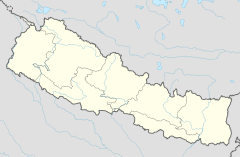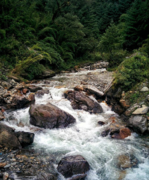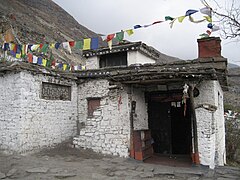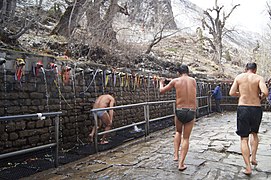Muktinath
This article has multiple issues. Please help improve it or discuss these issues on the talk page. (Learn how and when to remove these template messages)
|
| Muktinath Temple | |
|---|---|
Muktinath (Dhawalagiri) | |
| Country | Nepal |
Location in Nepal | |
| Geographic coordinates | 28°49′01″N 83°52′18″E / 28.816854°N 83.871742°E |
| Architecture | |
| Type | Pagoda |
| Elevation | 3,762 m (12,343 ft) |
Muktinath is a

This temple is considered to be the 106th of the 108
Buddhists call it
The site is close to the village of Ranipauwa, which is sometimes mistakenly called Muktinath.
Legend

The Tibetan Buddhist tradition states that Guru Rinpoche, also known as Padmasambhava, the founder of Tibetan Buddhism, meditated at Muktinath on his way to Tibet. This temple is praised by many saints of the Hindu tradition. Scripts narrating the temple's importance are available in the Vishnu Purana with the Gandaki Mahatmya.[clarification needed]
The waterway downstream from Muktinath along Kali Gandaki is the source of the shilas or
It has 108 water springs, a number that carries great significance in Hindu philosophy. As an example of the mystery surrounding the number 108, Hindu astrology mentions 12 zodiacs (rashi) and nine planets (navagraha), giving a total of 108 combinations. The 27 lunar mansions (nakshatras) are divided into four quarters (or padas) each giving a combination of 108 padas in total.
Architecture
The central shrine of Muktinath is considered by Hindu
The
Religious significance
Hinduism
Muktinath is sacred to the
The pontiff of
Shakti Pitha
The Muktinath Temple is considered a Shakti Pitha for a yatra. It is one of the 108 Siddhpeeth and is named Mahadevi [Devibhagwat 7.14]. Shakti Pithas are sacred abodes of Shakti (primordial cosmic energy), formed by the falling body parts of the corpse of Sati when Shiva carried it as he wandered. 51 Shakti Pithas are revered by Shaktism, connecting them to the 51 alphabets in Sanskrit. Each Shakti Pitha has a Shakti shrine and a Bhairav shrine in its temple. The Shakti of Muktinath is addressed as "Gandaki Chandi", and the Bhairava as "Chakrapani". Sati's right cheek is believed to have fallen there.[5][6][7]
Sri Murti Mahatmyam
Muktinath is revered as a place on earth to host all five elements (fire, water, sky, earth, and air) from which all material things in the universe are made. Along with the ambient earth, air, and sky, there is a spring at the Jwala Mai Temple with a flame just above the water, fueled by a naturally occurring gas outflow, giving the appearance of the water itself burning.[8]
Buddhism
Worship is conducted by Buddhists, with a Buddhist monk present. A local nun manages the pujas (prayer rituals) in the temple. Pilgrims are expected to offer a
Tourism
Muktinath, being a famous religious and tourism locations, receives thousands of visitors every year. According to the data provided by the Jomsom-based information centre of the Annapurna Conservation Area Project (ACAP), 9,105 foreigners visited Muktinath in April 2018 alone, among whom 4,537 Picture in map of nepal
Gallery
See also
References
![]()















